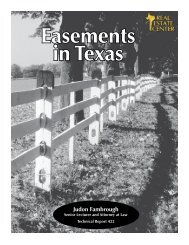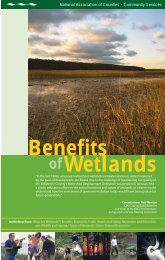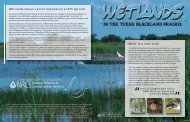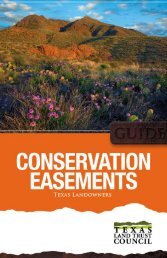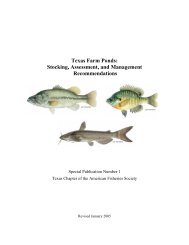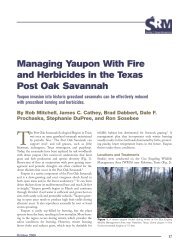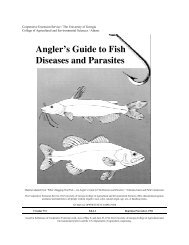Managing for Wood Ducks in East Texas - Trinity Waters
Managing for Wood Ducks in East Texas - Trinity Waters
Managing for Wood Ducks in East Texas - Trinity Waters
Create successful ePaper yourself
Turn your PDF publications into a flip-book with our unique Google optimized e-Paper software.
Photo: Carl Frentress<br />
<strong>Wood</strong> ducks have<br />
the potential to<br />
rema<strong>in</strong> one of the<br />
outstand<strong>in</strong>g waterfowl<br />
species <strong>in</strong> <strong>Texas</strong> if<br />
proper habitat<br />
is reta<strong>in</strong>ed and<br />
effective management<br />
plans are put<br />
<strong>in</strong>to action.<br />
Although these birds occupy wild <strong>for</strong>est areas, wood ducks also can be featured<br />
<strong>in</strong> urban and suburban wildlife management plans because they are adaptable to<br />
human activity. The numerous ponds, lakes and streams <strong>in</strong> city parks offer good<br />
locations <strong>for</strong> wood duck nest boxes and habitat improvement practices. Projects<br />
of this type exist throughout the state. In these sett<strong>in</strong>gs, wood ducks are a<br />
valuable resource to wildlife watchers.<br />
With this versatility of response to management programs and the potential <strong>for</strong><br />
<strong>in</strong>volvement of persons from various sectors of the wildlife arena, wood ducks<br />
can become the focus of a large-scale, <strong>in</strong>tegrated wildlife management ef<strong>for</strong>t <strong>in</strong><br />
the state. However, the success of such a program will depend on cooperation<br />
among government, public and private concerns.<br />
Fortunately, with the wood duck we have the potential to engage <strong>in</strong> an effective<br />
management program. Yet this program must rely not only on the participation<br />
of the <strong>Texas</strong> Parks and Wildlife Department (TPWD), but also on <strong>in</strong>dividual<br />
landowners, concerned citizens, other government agencies, private timber<br />
companies, civic groups, private wildlife organizations, youth organizations and<br />
other factions <strong>in</strong>terested <strong>in</strong> contribut<strong>in</strong>g to the betterment of the wood duck <strong>in</strong><br />
<strong>Texas</strong>. With this bird and its habitats, we are all challenged to demonstrate our<br />
s<strong>in</strong>cerity <strong>in</strong> meet<strong>in</strong>g our stewardship responsibilities.The two most beneficial<br />
actions <strong>for</strong> wood ducks are to conserve <strong>for</strong>ested wetland habitat and conduct<br />
effective nest box projects. For many conservationists, nest boxes allow <strong>for</strong><br />
immediate and productive activities. Below is a discussion of considerations<br />
appropriate <strong>for</strong> successful use of nest boxes to benefit wood ducks.<br />
9



